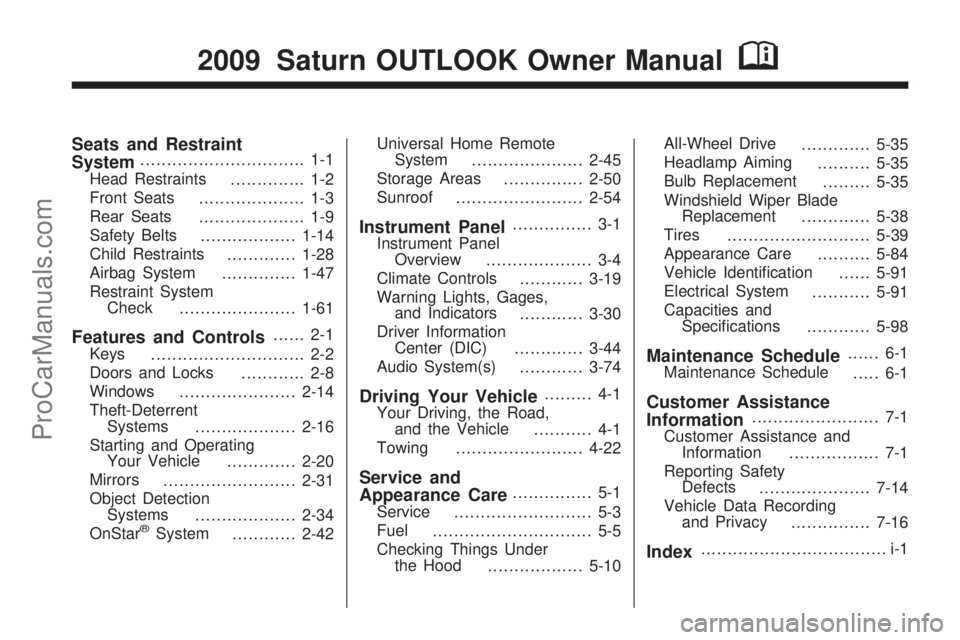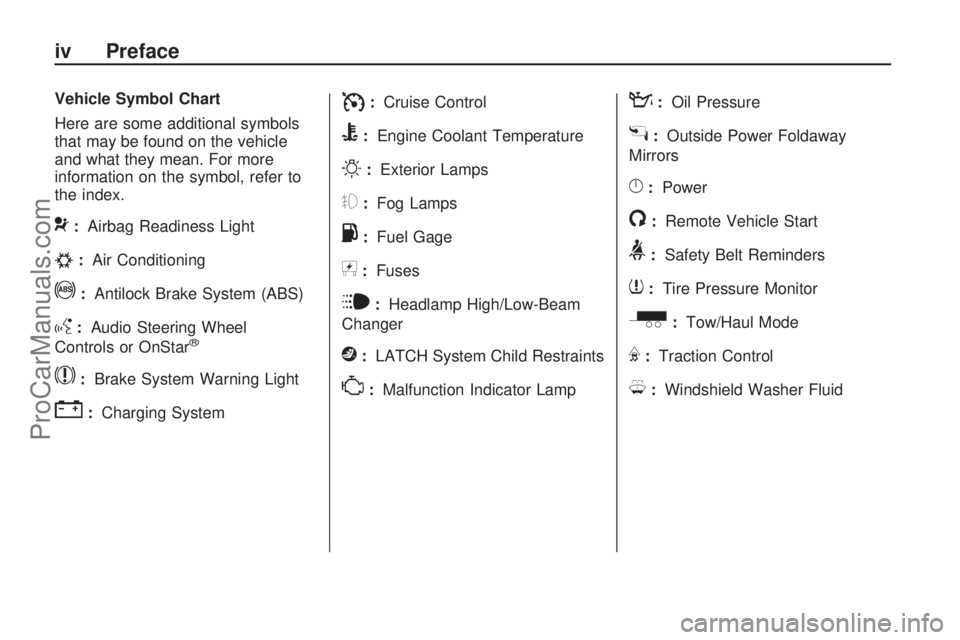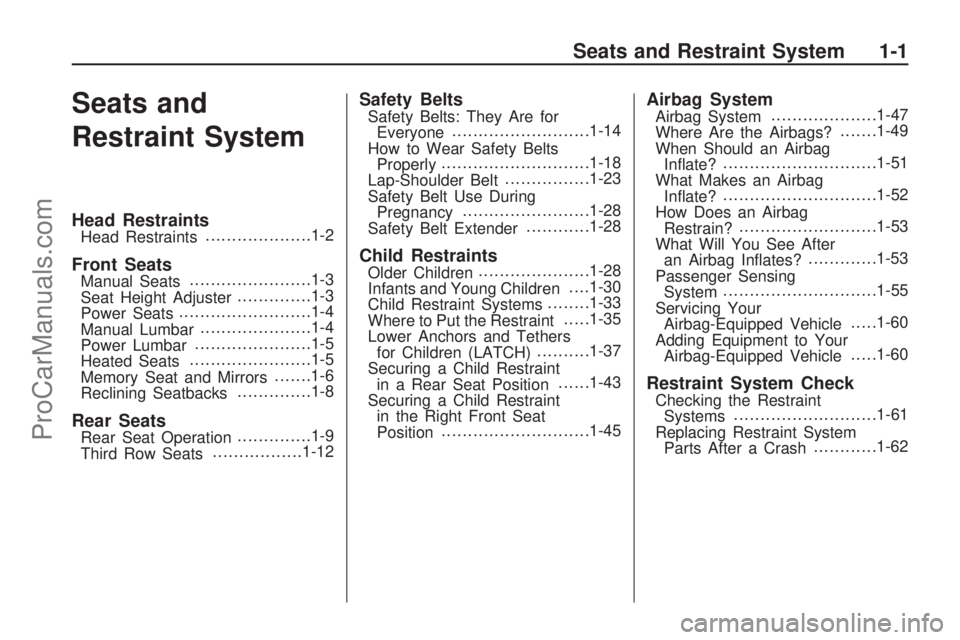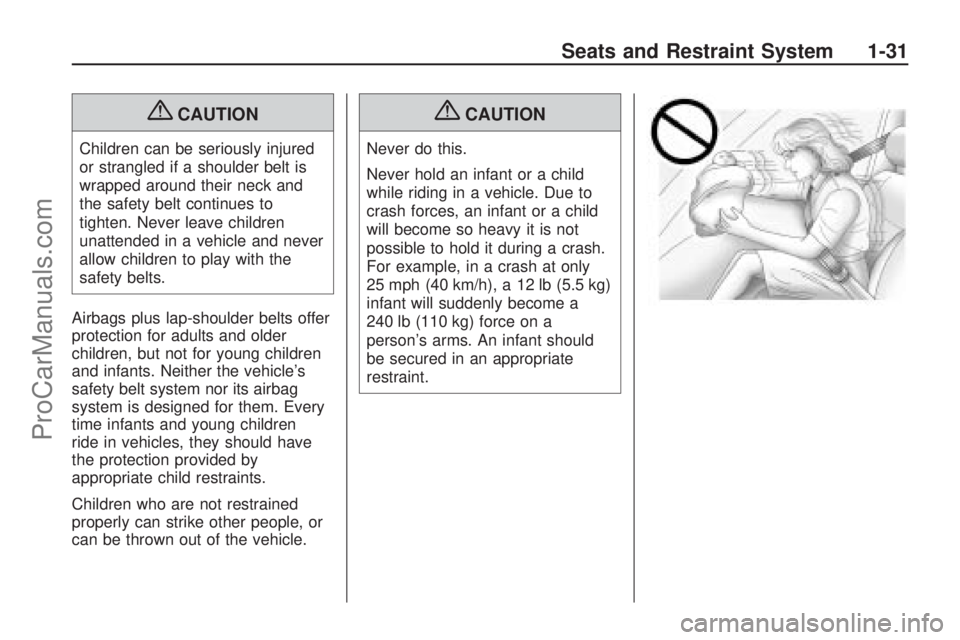child restraint SATURN OUTLOOK 2009 Owners Manual
[x] Cancel search | Manufacturer: SATURN, Model Year: 2009, Model line: OUTLOOK, Model: SATURN OUTLOOK 2009Pages: 432, PDF Size: 2.48 MB
Page 1 of 432

Seats and Restraint
System............................... 1-1
Head Restraints
.............. 1-2
Front Seats
.................... 1-3
Rear Seats
.................... 1-9
Safety Belts
..................1-14
Child Restraints
.............1-28
Airbag System
..............1-47
Restraint System
Check
......................1-61
Features and Controls...... 2-1
Keys
............................. 2-2
Doors and Locks
............ 2-8
Windows
......................2-14
Theft-Deterrent
Systems
...................2-16
Starting and Operating
Your Vehicle
.............2-20
Mirrors
.........................2-31
Object Detection
Systems
...................2-34
OnStar
®System
............2-42Universal Home Remote
System
.....................2-45
Storage Areas
...............2-50
Sunroof
........................2-54
Instrument Panel............... 3-1
Instrument Panel
Overview
.................... 3-4
Climate Controls
............3-19
Warning Lights, Gages,
and Indicators
............3-30
Driver Information
Center (DIC)
.............3-44
Audio System(s)
............3-74
Driving Your Vehicle......... 4-1
Your Driving, the Road,
and the Vehicle
........... 4-1
Towing
........................4-22
Service and
Appearance Care............... 5-1
Service
.......................... 5-3
Fuel
.............................. 5-5
Checking Things Under
the Hood
..................5-10All-Wheel Drive
.............5-35
Headlamp Aiming
..........5-35
Bulb Replacement
.........5-35
Windshield Wiper Blade
Replacement
.............5-38
Tires
...........................5-39
Appearance Care
..........5-84
Vehicle Identi�cation
......5-91
Electrical System
...........5-91
Capacities and
Speci�cations
............5-98
Maintenance Schedule...... 6-1
Maintenance Schedule
..... 6-1
Customer Assistance
Information........................ 7-1
Customer Assistance and
Information
................. 7-1
Reporting Safety
Defects
.....................7-14
Vehicle Data Recording
and Privacy
...............7-16
Index................................... i-1
2009 Saturn OUTLOOK Owner ManualM
ProCarManuals.com
Page 4 of 432

Vehicle Symbol Chart
Here are some additional symbols
that may be found on the vehicle
and what they mean. For more
information on the symbol, refer to
the index.
9:Airbag Readiness Light
#:Air Conditioning
!:Antilock Brake System (ABS)
g:Audio Steering Wheel
Controls or OnStar®
$:Brake System Warning Light
":Charging System
I:Cruise Control
B:Engine Coolant Temperature
O:Exterior Lamps
#:Fog Lamps
.:Fuel Gage
+:Fuses
i:Headlamp High/Low-Beam
Changer
j:LATCH System Child Restraints
*:Malfunction Indicator Lamp
::Oil Pressure
g:Outside Power Foldaway
Mirrors
}:Power
/:Remote Vehicle Start
>:Safety Belt Reminders
7:Tire Pressure Monitor
_:Tow/Haul Mode
F:Traction Control
M:Windshield Washer Fluid
iv Preface
ProCarManuals.com
Page 5 of 432

Seats and
Restraint System
Head RestraintsHead Restraints....................1-2
Front SeatsManual Seats.......................1-3
Seat Height Adjuster..............1-3
Power Seats.........................1-4
Manual Lumbar.....................1-4
Power Lumbar......................1-5
Heated Seats.......................1-5
Memory Seat and Mirrors.......1-6
Reclining Seatbacks..............1-8
Rear SeatsRear Seat Operation..............1-9
Third Row Seats.................1-12
Safety BeltsSafety Belts: They Are for
Everyone..........................1-14
How to Wear Safety Belts
Properly............................1-18
Lap-Shoulder Belt................1-23
Safety Belt Use During
Pregnancy........................1-28
Safety Belt Extender............1-28
Child RestraintsOlder Children.....................1-28
Infants and Young Children. . . .1-30
Child Restraint Systems........1-33
Where to Put the Restraint.....1-35
Lower Anchors and Tethers
for Children (LATCH)..........1-37
Securing a Child Restraint
in a Rear Seat Position......1-43
Securing a Child Restraint
in the Right Front Seat
Position............................1-45
Airbag SystemAirbag System....................1-47
Where Are the Airbags?.......1-49
When Should an Airbag
In�ate?.............................1-51
What Makes an Airbag
In�ate?.............................1-52
How Does an Airbag
Restrain?..........................1-53
What Will You See After
an Airbag In�ates?.............1-53
Passenger Sensing
System.............................1-55
Servicing Your
Airbag-Equipped Vehicle.....1-60
Adding Equipment to Your
Airbag-Equipped Vehicle.....1-60
Restraint System CheckChecking the Restraint
Systems...........................1-61
Replacing Restraint System
Parts After a Crash............1-62
Seats and Restraint System 1-1
ProCarManuals.com
Page 22 of 432

How to Wear Safety Belts
Properly
This section is only for people of
adult size.
Be aware that there are special
things to know about safety
belts and children. And there are
different rules for smaller children
and infants. If a child will be riding in
the vehicle, seeOlder Children on
page 1-28orInfants and Young
Children on page 1-30. Follow those
rules for everyone’s protection.
It is very important for all occupants
to buckle up. Statistics show that
unbelted people are hurt more often
in crashes than those who are
wearing safety belts.
Occupants who are not buckled up
can be thrown out of the vehicle
in a crash. And they can strike
others in the vehicle who are
wearing safety belts.First, before you or your
passenger(s) wear a safety belt,
there is important information
you should know.
Sit up straight and always keep your
feet on the �oor in front of you.
The lap part of the belt should be
worn low and snug on the hips, just
touching the thighs. In a crash,this applies force to the strong
pelvic bones and you would be less
likely to slide under the lap belt.
If you slid under it, the belt would
apply force on your abdomen.
This could cause serious or even
fatal injuries. The shoulder belt
should go over the shoulder
and across the chest. These parts
of the body are best able to take belt
restraining forces.
The shoulder belt locks if there is a
sudden stop or crash.
1-18 Seats and Restraint System
ProCarManuals.com
Page 27 of 432

Lap-Shoulder Belt
All seating positions in the vehicle
have a lap-shoulder belt.
If you are using a rear seating
position with a detachable safety
belt and the safety belt is not
attached, seeThird Row Seats on
page 1-12for instruction on
reconnecting the safety belt to the
mini-buckle.
The following instructions explain
how to wear a lap-shoulder belt
properly.
1. Adjust the seat, if the seat is
adjustable, so you can sit up
straight. To see how, see “Seats”
in the Index.2. Pick up the latch plate and pull
the belt across you. Do not let
it get twisted.
The lap-shoulder belt may lock if
you pull the belt across you
very quickly. If this happens, let
the belt go back slightly to
unlock it. Then pull the belt
across you more slowly.
If the shoulder portion of a
passenger belt is pulled out all
the way, the child restraint
locking feature may be engaged.
If this happens, let the belt go
back all the way and start again.3. Push the latch plate into the
buckle until it clicks.
4. Pull up on the latch plate to
make sure it is secure. If the belt
is not long enough, seeSafety
Belt Extender on page 1-28.
Position the release button on
the buckle so that the safety belt
could be quickly unbuckled if
necessary.
Seats and Restraint System 1-23
ProCarManuals.com
Page 29 of 432

To move it down, push down on the
button (A) and move the height
adjuster to the desired position. You
can move the height adjuster up by
pushing up on the shoulder belt
guide.
After the adjuster is set to the desired
position, try to move it down without
pushing the button to make sure it
has locked into position.
Safety Belt Pretensioners
This vehicle has safety belt
pretensioners for the front outboard
occupants. Although the safety
belt pretensioners cannot be seen,
they are part of the safety belt
assembly. They can help tighten the
safety belts during the early
stages of a moderate to severe
frontal, near frontal, or rear crash if
the threshold conditions for
pretensioner activation are met.
And, for vehicles with side impact
airbags, safety belt pretensioners
can help tighten the safety belts in a
side crash or a rollover event.Pretensioners work only once. If the
pretensioners activate in a crash,
they will need to be replaced,
and probably other new parts for the
vehicle’s safety belt system. See
Replacing Restraint System
Parts After a Crash on page 1-62.
Rear Safety Belt Comfort
Guides
Rear shoulder belt comfort guides
may provide added safety belt
comfort for older children who have
outgrown booster seats and for
some adults. When installed on a
shoulder belt, the comfort guide
positions the shoulder belt away
from the neck and head.
Seats and Restraint System 1-25
ProCarManuals.com
Page 32 of 432

Safety Belt Use During
Pregnancy
Safety belts work for everyone,
including pregnant women. Like all
occupants, they are more likely
to be seriously injured if they do not
wear safety belts.
A pregnant woman should wear a
lap-shoulder belt, and the lap portion
should be worn as low as possible,
below the rounding, throughout
the pregnancy.The best way to protect the fetus is
to protect the mother. When a
safety belt is worn properly,
it is more likely that the fetus will not
be hurt in a crash. For pregnant
women, as for anyone, the key to
making safety belts effective is
wearing them properly.
Safety Belt Extender
If the vehicle’s safety belt will fasten
around you, you should use it.
But if a safety belt is not long
enough, your dealer/retailer will
order you an extender. When you
go in to order it, take the heaviest
coat you will wear, so the extender
will be long enough for you. To
help avoid personal injury, do not let
someone else use it, and use it
only for the seat it is made to �t. The
extender has been designed for
adults. Never use it for securing
child seats. To wear it, attach it to
the regular safety belt. For more
information, see the instruction
sheet that comes with the extender.
Child Restraints
Older Children
Older children who have outgrown
booster seats should wear the
vehicle’s safety belts.
1-28 Seats and Restraint System
ProCarManuals.com
Page 33 of 432

The manufacturer’s instructions that
come with the booster seat, state
the weight and height limitations for
that booster. Use a booster seat
with a lap-shoulder belt until
the child passes the below �t test:
Sit all the way back on the
seat. Do the knees bend at the
seat edge? If yes, continue.
If no, return to the booster seat.
Buckle the lap-shoulder
belt. Does the shoulder belt rest
on the shoulder? If yes,
continue. If no, try using the rear
safety belt comfort guide. See
“Rear Safety Belt Comfort
Guides” underLap-Shoulder Belt
on page 1-23for more
information. If the shoulder belt
still does not rest on the shoulder,
then return to the booster seat.
Does the lap belt �t low and snug
on the hips, touching the thighs?
If yes, continue. If no, return
to the booster seat.
Can proper safety belt �t be
maintained for the length of
the trip? If yes, continue. If no,
return to the booster seat.
Q:What is the proper way to
wear safety belts?
A:An older child should wear a
lap-shoulder belt and get the
additional restraint a shoulder
belt can provide. The shoulder
belt should not cross the face or
neck. The lap belt should �t
snugly below the hips, just
touching the top of the thighs.
This applies belt force to
the child’s pelvic bones in a
crash. It should never be worn
over the abdomen, which
could cause severe or even fatal
internal injuries in a crash.
Also see “Rear Safety Belt Comfort
Guides” underLap-Shoulder Belt
on page 1-23.According to accident statistics,
children and infants are safer when
properly restrained in a child
restraint system or infant restraint
system secured in a rear seating
position.
In a crash, children who are not
buckled up can strike other people
who are buckled up, or can be
thrown out of the vehicle. Older
children need to use safety
belts properly.
Seats and Restraint System 1-29
ProCarManuals.com
Page 34 of 432

{CAUTION
Never do this.
Never allow two children to wear
the same safety belt. The safety
belt can not properly spread the
impact forces. In a crash, the two
children can be crushed together
and seriously injured. A safety
belt must be used by only one
person at a time.
{CAUTION
Never do this.
Never allow a child to wear the
safety belt with the shoulder belt
behind their back. A child can be
seriously injured by not wearing
the lap-shoulder belt properly. In a
crash, the child would not be
restrained by the shoulder belt.
The child could move too far
forward increasing the chance of
head and neck injury. The child
might also slide under the lap
belt. The belt force would then be
applied right on the abdomen.
That could cause serious or fatal
injuries. The shoulder belt should
go over the shoulder and across
the chest.
Infants and Young
Children
Everyone in a vehicle needs
protection! This includes infants and
all other children. Neither the
distance traveled nor the age and
size of the traveler changes the
need, for everyone, to use safety
restraints. In fact, the law in
every state in the United States and
in every Canadian province says
children up to some age must
be restrained while in a vehicle.
1-30 Seats and Restraint System
ProCarManuals.com
Page 35 of 432

{CAUTION
Children can be seriously injured
or strangled if a shoulder belt is
wrapped around their neck and
the safety belt continues to
tighten. Never leave children
unattended in a vehicle and never
allow children to play with the
safety belts.
Airbags plus lap-shoulder belts offer
protection for adults and older
children, but not for young children
and infants. Neither the vehicle’s
safety belt system nor its airbag
system is designed for them. Every
time infants and young children
ride in vehicles, they should have
the protection provided by
appropriate child restraints.
Children who are not restrained
properly can strike other people, or
can be thrown out of the vehicle.
{CAUTION
Never do this.
Never hold an infant or a child
while riding in a vehicle. Due to
crash forces, an infant or a child
will become so heavy it is not
possible to hold it during a crash.
For example, in a crash at only
25 mph (40 km/h), a 12 lb (5.5 kg)
infant will suddenly become a
240 lb (110 kg) force on a
person’s arms. An infant should
be secured in an appropriate
restraint.
Seats and Restraint System 1-31
ProCarManuals.com